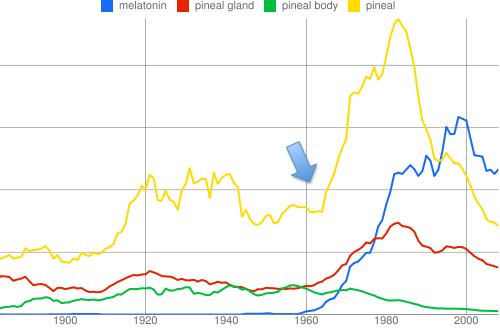I had started a big post about melatonin sometime in March to coincide with my lecture on biological rhythms on our neurobiology course, but as stuff happened I never actually finished it. As things have it though, I was asked to cover for another teacher lecturing last week about melatonin and the pineal gland for second term medical students, so I got a reason to re-visit melatonin and the blog post. I hope to have it up soon, but I haven't recovered completely and I'm still taking it easy with my work load so blogging is not really a priority right now. But as a short preface to that post, I thought we could take a look at what information we can extract about melatonin and the pineal gland from Google NGrams.

Melatonin is a hormone related to the neurotransmitter serotonin. Most people may have heard about it in the context of jet-lag or insomnia and perhaps different supplements or medications one might take to counteract them. Indeed melatonin is secreted when it's dark by the pineal gland in the brain as a general "night-time signal", although it doesn't stimulate sleep by itself.
We can see very clearly in the ngram above that "melatonin", "pineal gland" as well as the general term "pineal" have had a clear rise since the start of the 1960's. This makes perfect sense since melatonin was first isolated in 1958 from cow pineal glands. It was named and some of its effects were described in a 1960 paper by the same researchers. However, it was already known since the start of the 20th century that pineal gland extracts had some biological effects, before the hormone was isolated. This is detectable in another ngram, but could it also be related to the sharp peak in the term "pineal" that we see in the first decades of the 1900's in the ngram above?
The terms "pineal" and "pineal gland" go back quite far, reflecting the fact that the pineal gland has been known anatomically, and to some extent functionally, for quite a long time. The term "pineal body" is a bit of a curiosity since you often see it in old literature, but it doesn't seem to be as old or to reach the same prominence as "pineal gland" at all, which is surprising, at least to me. I thought that "pineal body" would be the older term and that it was eventually replaced by "pineal gland". Not so apparently.
No comments:
Post a Comment
Note: Only a member of this blog may post a comment.